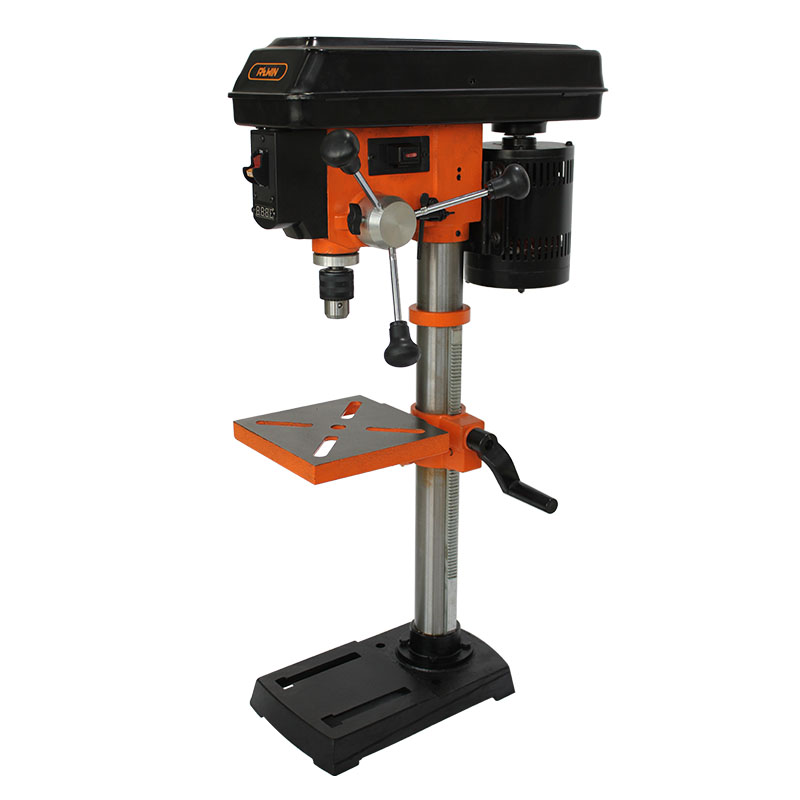అన్నీడ్రిల్ ప్రెస్లుఅదే ప్రాథమిక భాగాలను కలిగి ఉండండి. అవి కాలమ్లో అమర్చిన తల మరియు మోటారును కలిగి ఉంటాయి. కాలమ్లో ఒక పట్టిక ఉంది, అది పైకి క్రిందికి సర్దుబాటు చేయవచ్చు. వాటిలో ఎక్కువ భాగం కోణాల రంధ్రాల కోసం వంగి ఉండవచ్చు.
తలపై, మీరు డ్రిల్ చక్తో ఆన్/ఆఫ్ స్విచ్, ఆర్బోర్ (స్పిండిల్) ను కనుగొంటారు. వైపు మూడు హ్యాండిల్స్ సమూహాన్ని తిప్పడం ద్వారా ఇది పెంచబడుతుంది మరియు తగ్గించబడుతుంది. సాధారణంగా, డ్రిల్ చక్ కదలగల మూడు అంగుళాల ప్రయాణం పైకి క్రిందికి ఉంటుంది. మరో మాటలో చెప్పాలంటే, మీరు పట్టిక యొక్క ఎత్తును సర్దుబాటు చేయకుండా మూడు అంగుళాల లోతులో రంధ్రం చేయవచ్చు.
పదార్థం టేబుల్పై ఉంచబడుతుంది మరియు చేతితో ఉంచబడుతుంది లేదా స్థానంలో బిగించబడుతుంది. అప్పుడు మీరు డ్రిల్ చక్లోకి ఉంచిన బిట్ వరకు పట్టికను పైకి లేపండి. టర్నింగ్ బిట్ యొక్క వేగం సాధారణంగా తలపై వరుస స్టెప్ బెల్ట్ల ద్వారా నియంత్రించబడుతుంది. కొన్ని హై-ఎండ్ డ్రిల్ ప్రెస్లు వేరియబుల్-స్పీడ్ మోటార్లు ఉపయోగిస్తాయి.
డ్రిల్ చేయడానికి సిద్ధంగా ఉన్నప్పుడు, దాన్ని ఆన్ చేసి నెమ్మదిగా హ్యాండిల్స్లో ఒకదాన్ని ముందుకు మరియు క్రిందికి లాగండి. మీరు ఉపయోగించే ఒత్తిడి మొత్తం మీరు డ్రిల్లింగ్ చేస్తున్న పదార్థంపై ఆధారపడి ఉంటుంది. ఉక్కు కలప కంటే ఎక్కువ ఒత్తిడి అవసరం. పదునైన బిట్తో, మీరు డ్రిల్ చేస్తున్నప్పుడు రంధ్రం నుండి వచ్చే షేవింగ్లు -దుమ్ము కాదు. లోహాన్ని డ్రిల్లింగ్ చేసేటప్పుడు, షేవింగ్లు ఒక పొడవైన మురిగా బయటకు వచ్చినప్పుడు మీరు సరైన ఒత్తిడిని ఉపయోగిస్తున్నారని ఒక సంకేతం. మెటల్ డ్రిల్లింగ్ అనేది ఒక ప్రక్రియ.
డ్రిల్ ప్రెస్ను ఉపయోగించినప్పుడు మీరు చూడవలసిన విషయాలు పొడవాటి జుట్టు మరియు నెక్లెస్లు. వాస్తవానికి, మీరు ఉపయోగించినప్పుడు మీరు ఎల్లప్పుడూ భద్రతా గ్లాసెస్ ధరించాలిడ్రిల్ ప్రెస్.
దయచేసి ప్రతి ఉత్పత్తి పేజీ దిగువన మాకు సందేశాన్ని పంపండి లేదా మీరు మాపై ఆసక్తి కలిగి ఉంటే “మమ్మల్ని సంప్రదించండి” పేజీ నుండి మా సంప్రదింపు సమాచారాన్ని కనుగొనవచ్చుబెంచ్టాప్ డ్రిల్ ప్రెస్లేదాఫ్లోర్ డ్రిల్ ప్రెస్.
పోస్ట్ సమయం: అక్టోబర్ -18-2022



